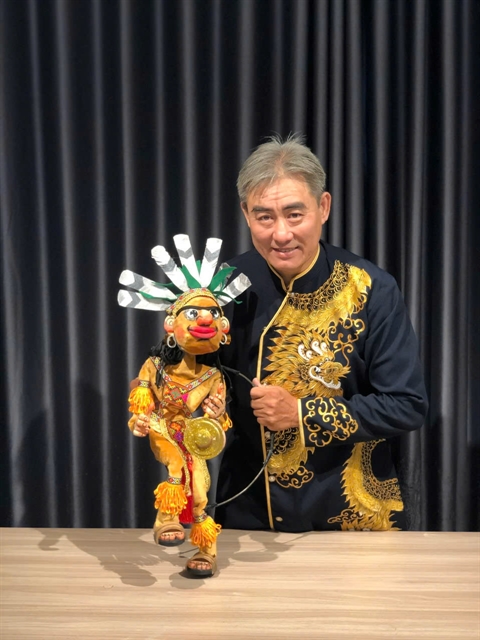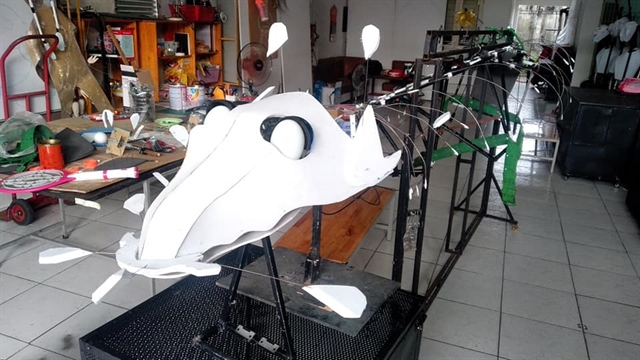 Opinion
Opinion

 |
| Artist Đặng Trí Đức with one of his favourite puppets. Photo courtesy of the artist |
Artist Đặng Trí Đức was born into a family with a strong artistic tradition, led by his father, Meritorious Artist Đặng Lợi, who made significant contributions to bringing Vietnamese water puppetry closer to the public. Đức is a leading sand painting performer and a puppet maker with decades of experience, specialising in making puppets for festivals.
He shared with Việt Nam News his perspective on Vietnamese puppetry and ways to develop this art.
Could you please share some insights into the history and cultural aspects of puppetry in Việt Nam?
Southern Việt Nam's unique culture, shaped by influences from the Chăm, Hoa, Khmer and local communities, is a direct result of its geographical setting. The region has a vast, interconnected river system that facilitates travel and cultural exchange.
In this region, various forms of puppetry are often combined with other types of performances. A good example is the "Hẩu" dance from the former Bình Dương Province (now part of HCM City). This dance includes the 'Hẩu' masked puppet, a mythical tiger-headed creature.
This differs from the North, where the village pond is typically at the centre. The communal pond serves as the traditional stage for popular water puppetry.
Water puppet shows take place on these ponds, with puppeteers hiding behind props to make it appear as though the puppets are moving on their own. This form of entertainment uses lights and effects, creating a magical experience for audiences.
It was also a significant part of the village's spiritual life. Local tales recount the story of sacred rituals, such as offering betel nuts through water puppetry performances.
Before 1968, the art form faced significant challenges, including a period when it was considered a form of superstition. Then came the war, which resulted in the loss of many master puppeteers and the ancient knowledge they possessed.
Until the first official water puppet troupes were created, the traditional puppeteers' village worked together with cultural authorities, each one bringing their own special performances to help revive the art.
What are the core requirements for a puppet artist?
In the art of puppetry, there are three core elements required: The art of creation, the art of manipulation, and the art of interaction.
For the creation part, the artist must have a deep understanding of anatomy and mechanics. This allows them to create a puppet that can be easily controlled and move flexibly, based on the artist's purpose.
 |
| Artist Đặng Trí Đức's puppet workshop in HCM City, where he crafts puppets for the city's festivals. Photo courtesy of the artist |
Next is the technique of controlling the puppet. To bring a puppet character to life on stage, the artist must rely on keen observation of the real world to find a way to translate those movements and feelings onto the puppet as authentically as possible.
Finally, audience interaction skills are crucial in a puppet show. This engagement is the heart of puppetry. Without it, performances can feel lifeless. If the show lacks creativity and connection, viewers -- especially children -- may only want to watch it once and not return for more.
However, many water puppet shows now lack interaction and only focus too much on technical skills, repeating the same content.
The real magic of puppetry lies in making the puppet feel alive, allowing it to live its own life on its own stage. However, with some shows, puppeteers come out to demonstrate how to control the puppets, which can reduce them to just props.
Which target group is puppetry geared towards in Việt Nam?
 |
| With decades of experience, artist Đặng Trí Đức continues to evolve his craft, applying new techniques to create the best festival puppets for HCM City’s events. Photo courtesy of the artist |
Puppetry audiences differ by age group, and each group tends to focus on specific themes.
From two and a half to six and a half years old, children become increasingly curious about the world and enjoy watching puppetry the most. Puppet shows for them can be anything from educational to humorous, and this group is the most drawn to puppet performances.
From then until 15, audiences appreciate story-driven puppet shows that include elements of conflict or battles. These themes capture their imagination at that age.
Above that, until 45, they enjoy puppet shows that reflect everyday life, from which they learn valuable lessons and gain insights.
For those over 45, puppet shows focusing on history, traditions, and cultural identity are more appealing -- especially those that highlight national identity.
What is your view of the current puppetry situation in Việt Nam and how can it be developed?
Currently, the rise of mobile devices means more people are interacting through screens rather than directly. This puts all performing arts at risk, not just puppetry.
However, social media is helping puppeteers reach their audiences and connect within the community, with street and interactive puppetry gaining popularity, especially on platforms like TikTok.
As Việt Nam opens up and integrates with the world, audiences can now access a broader range of puppet shows and festivals, both domestic and international.
While some believe the art form is dying and needs saving, it should evolve and adapt to today's society to thrive.
Three main factors will help the puppetry industry develop in Việt Nam.
First, the cultural authorities should pay more attention to puppetry and provide support through policies and other resources. Authorities should integrate puppetry into activities such as festivals, education, and tourism. Additionally, they should promote it through media coverage and professional competitions.
Second, puppetry professionals must continually innovate their content and performance styles, adapting to new methods and modern technologies. They should also explore new ways to engage with audiences and respond to contemporary societal needs. This approach will help foster a habit of enjoying traditional puppetry among viewers.
Last, we need a comprehensive strategy to promote puppetry to young children and their parents through targeted campaigns, festivals and the education system.
This initiative will help build a new, knowledgeable audience that appreciates high-quality puppetry. VNS